
from
https://www.soundandvision.com/content/walmart-weighs-tvmovie-streaming-service
The owners of this theater knew their previous media space was out of date. They had been using the same equipment for about 13 years — that’s a lifetime in the world of home electronics. But they were content. The components worked, the space was large enough to host friends and family, and they had long ago mastered how to work the system. It would take something major to spur them to renovate.
Related: How to Protect Your Home From Water Damage
Recently, something big did happen: Their home theater flooded. A leaky bathroom pipe located directly above the theater sent water into the room, damaging the ceiling, walls, and much of the furnishings. The owners figured this was their sign to update the space.
They contacted a trifecta of experts to handle the transformation: Mike Murphy Construction Consulting, Amy DeVault Interior Design and DSI Luxury Technology, of Los Angeles. Together, this team created an amazing viewing environment for the homeowners, which earned the space a Gold Award for the Electronic House Home of the Year Contest in the Best Home Theater $75,000-$150,000 category.
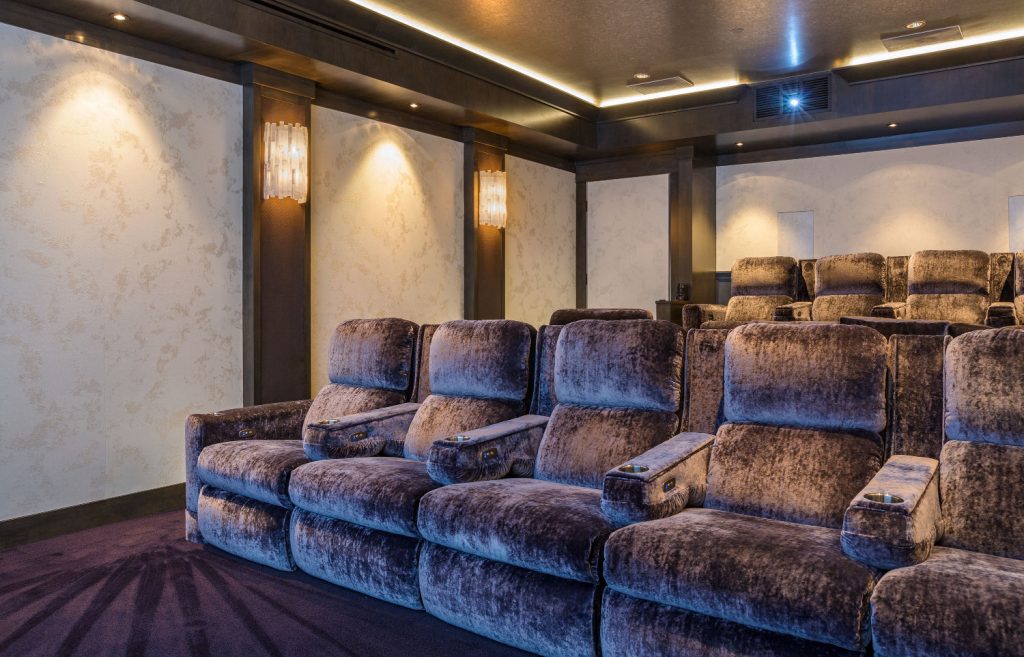
See more home theater award winners here and here
Walls were moved and soffits removed to provide more headroom and better sightlines from the seating area to the new projection screen; a fresh, modern interior design complete with new furniture was implemented; and a suite of state-of-the-art A/V gear along with a Savant control system was integrated.
Getting the room into tip-top shape was the first step in a process that would bring this theater into the upper echelon of performance. “We didn’t have a lot of ceiling height to work with, only about 9 feet, so it was a tricky engineering feat working around soffits and getting the screen where it the best position,” relates DSI principal Eric Thies.
“Our main objective when it came to selecting equipment for the new space was that the components be very current and have some staying power — tech that would have a long life and not become obsolete quickly,” adds Thies. “For example, we selected a 4K laser projector instead of an LED projector because we know that laser will be around for some time. The homeowners will never need to change a bulb or worry about their image losing brightness.”
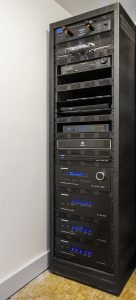
DSI complemented the Digital Projection International (DPI) projector with an assortment of other 4K-compatible equipment, including a Kaleidescape movie server, DirecTV cable box, and Apple TV. DSI also rounded out the entertainment options with legacy components like a Sony PlayStation and even a VCR for the owners’ collection of VHS tapes.
A 17-speaker Dolby Atmos system handled by JBL Synthesis speakers and AudioControl electronics delivers realistic 3D audio to the space. Some of the speakers were planted into the room’s existing columns and covered with acoustical fabric. “The speakers are completely disguised, and the JBL Synthesis system ensures that they’ll sound great for another 13-plus years,” Thies says.
Because the owners would be watching old movies on VHS, as well as TV programs and sporting events, the screen would need to accommodate not just the super wide 2.35:1 aspect ratios of some 4K content, but also less-wide 16:9 content and possibly even 4:3. A masking system was applied to the theater’s 12-foot-wide acoustically transparent Vutec screen to alter the aspect ratio to suit whatever content the family chooses. The fabric masking is motorized to move automatically, thanks to its integration into the Savant controls.

In addition to ensuring that the A/V sources, projector and masking system are in sync, Savant and a Lutron RadioRA system simplify the control of the room lighting. The owners can use a keypad at the theater entrance or an app on their smartphone to engage a lighting scene for before, during and after viewing. Programmed scenes are accounted for such as Movie, Intermission, Pause, and Clean Up, giving this theater even more stamina to endure the test of time.
Systems & Equipment
The post Flood Finally Inspires Home Theater Redo appeared first on Electronic House.
For some time, Amazon had the smart display category covered with a variety of form factors. Now Google has joined the pack with the introduction of its first Smart Display from Lenovo. Google Assistant is built in, so the display, which comes in 8- and 10-inch models, still listens for your voice commands. But now, there’s something to look at, including Google Maps, Calendar, Photos and more.
Ask YouTube to play anything: how-to videos, cooking videos, product reviews, you name it! And, with every Smart Display, you get three free months of YouTube Premium (for new subscribers).
If you have a YouTubeTV membership, you can watch live or recorded TV in your library. The next time you want to turn on the game, you can say “Hey Google, watch ESPN” to start streaming. Many other popular video services are supported too, including HBO Now, Google Play Movies & TV and Crackle.
With video calling on Google Duo, you can instantly connect with your closest friends and family on Smart Displays. Duo is also built in on Android phones and available for free on iOS, so you can call your friends and family hands-free across devices. Just say, “Hey Google, call Rachel” to start a high-quality video or audio call.
You can also glance at the display to see what’s happening around your house. “Hey Google, show me the family room” will link to a Nest Cam. Turn up the thermostat, dim the lights or change the color—all with your voice or a tap of a finger.
The built-in screen is helpful for browsing music, too.
The 8-inch HD version retails for $199.99 and the 10-inch Full-HD version for $249.99. Smart Displays are available at Walmart, BestBuy.com, Amazon.com, Costco.com, SamsClub.com, Lenovo.com and other stores.
JBL and LG plan to announce Google Smart Displays later this year.
The post Google Smart Displays: New Competition for Amazon Echo appeared first on Electronic House.
By Justin Schwartz, Founder and CEO of SAGE AV
Thanks to fairly low costs and easy installation, entry-level home automation products are now available to almost everyone. While these products are ideally suited for the DIYer, there are also a wide assortment of more advanced home automation systems that homeowners should have professionally installed. The challenge for homeowners is deciding when to DIY and when to hire the help of a professional.
Here’s a look at DIY technology versus what should be professionally installed to help you make the right choice.
Easy DIY Tech Upgrades
For homeowners who are dipping their toes into smart home technology for the first time, there are plenty of affordable products, like those listed below, that can be installed with the assistance of a professional installer:
Nest
The Nest line of products includes thermostats, security cameras and more. The Nest programmable thermostat connects to your home Wi-Fi and allows you to change the temperature in your home remotely via an app on your smartphone. Additionally, the Nest thermostat will identify your preferences and anticipate your temperature needs. The system also has a security option, which allows you to set up and monitor cameras inside and outside of your home. All of these cameras can also be accessed on your smartphone. Nest products are all fairly simple to set up and connect, some in 30 minutes or less.
Ring Doorbell
Ring is a standard looking doorbell that can be placed just outside your front door. It puts an end to second-guessing who’s at the door. It has a camera and microphone built in so you can use your phone or another device to see and talk to whoever’s ringing, even if you’re miles from home. The Ring doorbell offers plenty of technical support in the box and online, so installation should not be hard for the average DIYer. All one needs to do is line up the mounting bracket, drill holes, place the doorbell on the mounting bracket, and tightens the security screws.
Sonos Play
Sonos is a wireless speaker system for your smart home that you can control from an app on your smartphone or tablet. Sonos Play:1 or Play:5 speakers require only an electrical outlet and a Wi-Fi connection. A threaded mount allows you to put it on the wall or a speaker stand if you wish. You can pair either speaker with an Echo or Dot and play and control songs, shuffle playlists, and tune in radio stations or podcasts.
The Problem with DIY
Most homeowners who take a DIY approach tend to choose technology for single-device control instead of whole home automation. When problems arise, DIYers are relegated to phone or online customer service options to diagnose and fix problems. This can be a frustrating and time-consuming experience.
Why Use a Professional?
As mentioned above, there are certain smart home appliances that just need to be plugged to work and can be easily set up by DIYers. But, if you want your technology upgrades to start working together, things get a bit more complex. To start with, you’ll need to ensure all items you purchase are compatible with one another. When designing your system, you must plan not only for your current needs but for any additional upgrades you might want to make in the future. Professionals keep up with the latest trends and can help you create the best smart home environment for today and far into the future.
Also, as a homeowner, you have many options and may not be aware of them. This is where a professional comes in handy. A home systems professional can evaluate your lifestyle and explain the best options that deliver what you need within your desired budget.
The following smart home technologies should be set up by a professional:
Lighting Control Systems
It’s now possible to automate every light in your entire home and unify them behind a single, easy-to-use lighting control system. A professionally installed system will give you control over all of the lighting in your home. This includes table lamps, desk lamps, ceiling lamps as well as ceiling fans. The system will allow you to remotely access and have control over the lighting with a small remote control device or an integrated wall system. You can program motion detectors to identify when you walk into the room, turning on the lights and then after a time you have specified, they will also turn off or dim the lights.
You can also combine other smart lighting devices to create an array of effects. From colored accent lights to bedroom lamps that can wake you up by simulating the sunrise, your possibilities are virtually endless.
Motorized Shades and Window Treatments
When it comes to smart window shades and treatments, customization is key. A professional can help you choose the perfect system that marries both style and function. The best motorized shades and window treatments allow you to schedule adjustments at certain times or adjust them using just the touch of a button, voice command or your smartphone.
Distributed Audio Systems
A properly designed and installed audio system allows you to broadcast sound throughout the entire house, creating the perfect balance from room to room. Setting up a distributed audio system is no small task. It goes far beyond simply plugging in a few wireless speakers.
In fact, designing a great system requires the skill and knowledge to combine the proper speakers, receivers, amplifiers, and other components while taking into account the dynamics of each individual room as well as the vast design experience and deep product knowledge.
Unified Apps and Integrated Controls
With all of these different types of smart home devices, you will need a way to control them. Remember the frustrating days of multiple remotes? Today, home automation systems integrate various subsystems into unified apps and interfaces that bring you complete connectivity and control for every smart device.
DIY or Professionals?
The goal of any smart home installation is to make various devices work seamlessly together. This is where DIY tends to fall short. In order to fully experience the benefits a smart home can offer, it’s best to work with a professional who can coordinate with your contractor, interior designer, and electrician. They will work with you to design a system that meets your needs, using their knowledge of the latest smart technology for the home. By outsourcing this task, you’ll have the peace of mind in knowing your system is set up for optimal power, performance, and reliability.
The post Should You Install Home Automation Products Yourself? appeared first on Electronic House.
A new audio product from Revolution Acoustics has made it possible to install completely hidden audio sources in suspended ceilings. The patent-pending Ubiqui-T360, an innovative ceiling tile mounting system for the SSP6 Multiducer, brings the company’s constant-SPL planar wave audio technology to any drop ceiling, with no change in the visible appearance of the ceiling. The Ubiqui-T360 mount attaches in less than two minutes by a professional to  an existing ceiling tile, after which an SSP6 Multiducer unit is screwed into place. Once installed, each speaker provides 360 degree coverage of up to 1,200 square feet, with power handling of up to 150 watts (400 watts instantaneous peak). All you see is the ceiling tile; the speaker remains completely concealed.
an existing ceiling tile, after which an SSP6 Multiducer unit is screwed into place. Once installed, each speaker provides 360 degree coverage of up to 1,200 square feet, with power handling of up to 150 watts (400 watts instantaneous peak). All you see is the ceiling tile; the speaker remains completely concealed.
“With our new product, whole-home audio can really mean the whole home,” says Revolution Acoustics CEO Bob Katz. “The Ubiqui-T360 brings our revolutionary sonic quality to basements, home theaters, play rooms and workout rooms while providing an unmatched value proposition. We provide more uniform coverage, with constant SPL and frequency response, using far fewer speakers than you would need with traditional point-source ceiling speakers.”
The Ubiqui-T360 panel is sized to fit within 2’ x 2’ or 2’ x 4’ and metric equivalent sized ceiling panels and does not require any tools for installation.
If that’s not crafty enough, Revolution Acoustics offers a speaker that resembles a pendant light. The patent pending  Pendant360 is designed for indoor or outdoor use and provides 360 degree, immersive audio. The Pendant360 may also be mounted horizontally, enabling installation on poles or other open-wall structures.
Pendant360 is designed for indoor or outdoor use and provides 360 degree, immersive audio. The Pendant360 may also be mounted horizontally, enabling installation on poles or other open-wall structures.
“The Pendant360 is the only pendant speaker on the market that gives you consistent sound quality and frequency response no matter where you are standing or sitting,” says Katz, “and its small footprint and flat, paintable surface allows it to disappear into its surroundings.
Each Pendant360 unit measures only 13.8” x 13.8” x 0.6”.
The post Where to Hide Your Speakers? Put Them Above The Ceiling Tiles appeared first on Electronic House.
Are you getting the sleep you need? There’s one way to find out: use a sleep tracking device. According to sleep research from Parks Associates, nearly 29 million U.S. broadband households currently own a product that helps them track their sleep quality, representing less than half of the nearly 60 million consumers who report having at least one sleep problem. Sleep & IoT: Behaviors, Awareness, and Opportunities reveals 51% of U.S. broadband households are interested in buying a sleep tech device.
“Sleep tracking features of smart watches and fitness trackers are raising consumer awareness about lack of sleep—42% of consumers in U.S. broadband households are concerned their health will worsen due to poor sleep quality,” says Jennifer Kent, director, Research Quality and Product Development, Parks Associates. “Still, once a consumer understands their sleep patterns, then the issue becomes what to do about it? Most consumers have not brought up these concerns with their doctors, but many state they would be willing to see a doctor if sleep tech detected a problem with their sleep patterns.”
Related: How controllable lighting can promote better sleep
Sleep & IoT: Behaviors, Awareness, and Opportunities report 58% of U.S. broadband households rated as valuable a sensor, device, or app that can detect and track potential sleep apnea/respiratory issues, potential restless leg syndrome, or potential insomnia issues. Among them, 85% said they would be likely to see a doctor based on this information.
Wearable devices are a popular option for tracking sleep, but if you’d rather not go to bed with something on your wrist, there are many non-wearable products: Here are six of the best non-wearable sleep tracking devices, according to No Sleepless Nights:
EMfit QS
EMFit QS (Quantified Sleep) is a sleep monitor that lets you measure the effect sleep has on your health and sports 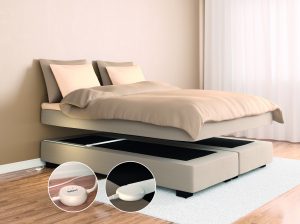 training. It measures heart and breathing rates, heart rate variability, stress levels, sleep quality, length of time for deep, REM, light sleep and total sleep, as well as movement activity (tossing and turning.) It detects whether the user is in or out of bed, awake or asleep, and measures snoring without the need to use a phone or microphone for detection.
training. It measures heart and breathing rates, heart rate variability, stress levels, sleep quality, length of time for deep, REM, light sleep and total sleep, as well as movement activity (tossing and turning.) It detects whether the user is in or out of bed, awake or asleep, and measures snoring without the need to use a phone or microphone for detection.
EMFIT QS gathers information automatically. Data is transferred by Wi-Fi or cellular signal to a cloud server accessed through a personal dashboard.
S+ by ResMed
S+ by ResMed sits on the nightstand where it listens to the sound of breathing. It also detects the movement of your upper body while you sleep.
The movement it detects consists of the expansion and relaxation of your chest as you breathe in and out, and overall body movements such as positional changes, arm twitches and shrugs.
You get a report on your smartphone with tips on how to improve your sleep. It includes software algorithms that recognise the combination of respiration and body-movement signals, so that the overall sleep state can be reliably assessed.
You receive tailored feedback from S+ by ResMed after your first night’s sleep, along with tips on how to improve your sleep. Later, after experts at S+ by ResMed analyze the date, you receive personalized feedback and suggestions.
Beddit 3
The Beddit 3 slides horizontally across the bed where you sleep, preferably under your heart. You cover it with a bedsheet and connect the attached cable to a power adapter which plugs into the wall. After setup it measures body movements in response to the heart pumping blood and breathing effort. It also monitors snoring, and the bedroom temperature and humidity. A smart alarm wakes hyou up at the best part of your sleep cycle.
RestOn Sleepace
The Sleepace from RestOn is another under the sheet or mattress monitor. It monitors hera rate, respiratory rate, sleep time and duration, and tracks the number of times you wake up, turn over, and leave the bed. The app aggregates all of this information and provides a detailed report of your resting patterns.
Withings Aura Smart Sleep System
The Withings Aura Smart Sleep System consists of a strap that sits under the mattress to measure your movement, a 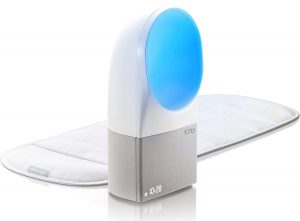 bedside unit that monitors the conditions of the room and produces light and sound to help you sleep, and a mobile app that shows your results. The bedside unit also works like an alarm clock, waking you up slowing during the lightest stages of sleep.
bedside unit that monitors the conditions of the room and produces light and sound to help you sleep, and a mobile app that shows your results. The bedside unit also works like an alarm clock, waking you up slowing during the lightest stages of sleep.
Besides monitoring real-time heart rate and respiratorand heart rate are analyzed to determine the actual sleep quality.
The post Get Your Zzzzs: 5 Sleep Trackers for a Better Night’s Rest appeared first on Electronic House.
Audio and video components are shrinking in size, and that’s good news for people who live in smaller spaces or who simply want something that’s easier to hide. Yamaha’s newest A/V receiver, the $650 RX-S602 Yamaha Slimline, stands just 4.5-inches high.
Although small in stature, it packs in plenty of top-notch technology. It supports 5.1 theater applications, as well as wireless whole-house audio through the inclusion of the company’s MusicCast platform. It also offers Amazon Alexa voice control capabilities.
“The RX-S602 makes powerful surround sound a reality for those living in a limited amount of space,” comments Robert Goedken, general manager, A/V division, Yamaha Corporation of America. “With MusicCast surround capability, in addition to Alexa voice control, this slimline receiver opens up a broad range of wireless options for the compact home audio setup.”
The RX-S602 supports a 5.1 surround-sound system with left, center, right and wireless speakers for left and right rear surrounds. The wireless whole-house MusicCast platform lets you stream audio content over Wi-Fi to any MusicCast-enabled component.
Related: How to ensure a solid Wi-Fi connection
Yamaha’s latest receiver incorporates voice control via the Amazon Alexa family of products, with additional support from Yamaha’s own MusicCast skill, available for download in the Alexa store.
The RX-S602 also supports 4K video at 60fps, and high dynamic range (HDR) formats such as Dolby Vision and Hybrid Log Gamma (HLG).
The receiver also includes wireless Bluetooth, Wi-Fi networking, Apple AirPlay and Spotify Connect. It also supports a variety of streaming services inlcuding Pandora, SiriusXM Internet Radio, TIDAL, Deezer and Napster, and incorporates a Zone 2 option allowing for the transmission of audio from an independent source to a separate set of speakers.
The RX-S602 A/V receiver also incorporates Yamaha’s YPAO auto-calibration and Cinema DSP technologies, which enable you to fine-tune the sound quality.
YPAO measures the room acoustics and system response and adjusts the receiver’s output for the best possible sound. Yamaha says its Cinema DSP 3D supports the creating of sound fields like movie theaters and concert halls.
The RX-S602 Slimline A/V receiver will be available this upcoming August.
The post Yamaha $650 Slimline Receiver, Small, Smart and Listens to Amazon Alexa appeared first on Electronic House.
Blessed with beautiful views of an inland lake, you better believe the owners of this home made sure to install massive windows — and lots of them. In fact, the majority of the lake-facing side of the house features wall-to-wall glass. As stunning as these sensational fenestrations might be, though, they do pose a few problems. Sunlight can fade furnishings and throw a glare onto TV screens. There’s also the heat generated by the incoming sunlight to combat. Lastly, unclad windows preserve none of an occupants’ privacy. Those windows needed some TLC.
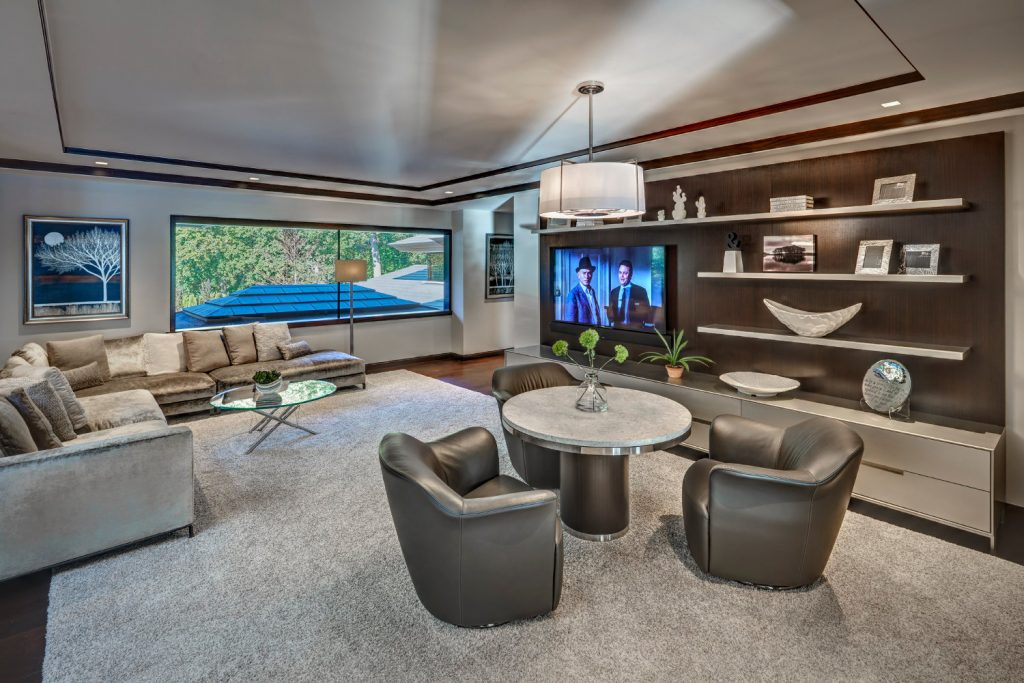
Thankfully, when the owners began designing plans for their new 15,000-square-foot home, they contacted the team at Spire Integrated Systems, of Traverse City, Mich. to add a few high-tech systems to handle the harsh afternoon sunshine. It was a project that earned the Electronic House Home of the Year Award for Best Smart Contemporary Smart Home, $150,000 and Up.
See more award winners here, here, and here
“When we first started working with the homeowners, our initial goal was to prewire it to the hilt and install a Lutron architectural lighting and shading system,” says Navot Shoresh, president of Spire. “Sunlight would affect a lot of the house, so these two technologies would be extremely beneficial to the homeowners; and, based on our years of experience, we expected that as the project progressed the owners would likely ask us to install other types systems.”
Shoresh’s hunch was spot on. Within a few weeks, plans for the smart home project grew to include a full-blown Savant automation system that spreads audio and video content to speakers and TVs housewide and controls a security system and surveillance cameras, motorized entry gate, numerous water features, motorized TV lifts — and, of course, the 256 lights and nearly 60 motorized shades.
The evolution of integrated systems made Savant an ideal choice for the job, which took two years to complete. “It would allow the owners themselves to create routines for the systems to follow, which makes them feel more empowered and not like hostages in their own home,” Shoresh explains. “It completely removed any trepidation of the technology.” Of course, he and his team configured the system fully for the family, with several customized scenes and automated scenarios for the ultimate in ease and simplicity.
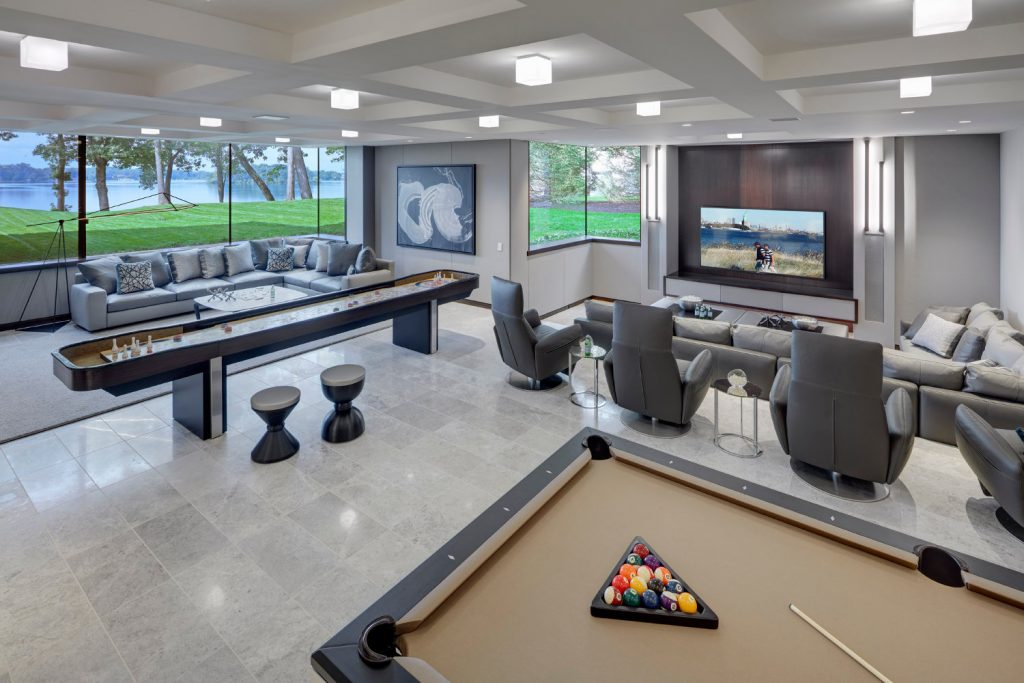
For example, lights inside and outside the home activate automatically based on the time of day and the occupancy. Shades lift up and down in sync with sunrise and sunset. Again, because maintaining a view was of the upmost importance, Spire programmed the shades to descend only halfway down the windows. “This would shade the interior of the house, yet still give the owners an unobstructed view outside,” Shoresh says.
Putting these systems on auto pilot saves the owners from the tedium of manual adjustments, but they find the Savant app on their mobile devices to be just has helpful. With a quick tap and swipe on the screen, they can access, monitor, and operate every Savant-connected device in the house, from the couch, the backyard, bedroom, or thousands of miles from home.
Entertainment was a natural complement to the lighting and shading systems, turning the home into the perfect place to entertain friends and family or to simply relax and unwind with music and a movie. Spire packed the house with plenty of options. Tucked neatly inside an equipment closet are cable boxes, Apple TV, and an Autonomic media server that streams music from Pandora, Tidal, and other online services to 26 listening zones equipped with a variety of Sonance interior and exterior speakers, plus a pair of Meridian floorstanding units in the living room for a two-channel stereo effect.
The Meridian duo is accompanied by a 70-inch Sony TV — just one of many. With TVs of this size, it’s easy for the technology to become the visual focal point. Rather than let that happen, the owners, architect and Spire team collaborated on a unique solution that completely removes at least a couple TVs from the spotlight.
“In order to maintain the views, we placed a 65-inch TV in the kitchen and a 36-inch TV in the master bedroom on motorized lifts that raise the displays from the floor and into viewing position,” Shoresh explains. “It was one of the most challenging parts of the project as we had to build a space below the floor to house each TV, move a slice of granite from the floor to allow the TV to pass, and then move that piece of granite back into positon to fit flush with the rest of the floor.”


The disappearing TV act was a success. Stowing them below the floor, the windows remain the main eye candy. Should the owners want to watch a show from their bed or catch the news while sipping coffee in the morning, they simply go to the Savant app on their iPad or iPhone, and command the Future Automation lifts to bring the TVs up into perfect viewing position. They go back into their hiding spots just as easily when the show is over.
This same lift-and-lower technique was applied to the shelving unit in the rec room. Except with this setup, the shelves, which hold liquor for the bar, rise from a locked cabinet below when the owner presses his thumb to a biometric reader. ”It’s a great way to keep a party from getting out of hand,” Shoresh says.


The motorized TVs and bar shelves are slick in design but still serve very practical purposes, just like every other smart system in this lake house. “We really focused on what made sense for the home and family and didn’t spend time or money on things that probably wouldn’t get used,” Shoresh remarks.
For example, two Meridian speakers instead of a full surround-sound setup suffice in the living room, and in-wall speakers were installed only in rooms where music listening would definitely happen — not throughout the entire house. Money and technology was invested in parts of the home deemed extremely important, like shading for the windows and scenery-saving TVs.
Systems & Equipment
The post Home Automation System Sets the Tone for Luxurious Lakeside Living appeared first on Electronic House.
The preorder price of the Roku TV is $150 through July 23. From July 24 to Oct. 15, the bundle will be available for $180 before shifting to its regular $200 cost. The bundle includes a pair of Roku TV speakers, a Roku TV voice remote, a Roku Touch tabletop remote, two power cables, and four AAA batteries.
Aiming to improve the sound quality of flat-panel televisions, the speakers comes with a voice control remote and sell for $150 for a limited time.
“Picture quality, a tremendous selection of content, value and ease of use make Roku TVs some of the most popular smart TVs on the market today,” says Anthony Wood, CEO. “Adding great audio dramatically enhances the way people experience their favorite entertainment. With this package, we’re able to offer our customers a simple and affordable way to further immerse themselves into the TV, movies and music they love, while providing them with a better whole-home entertainment experience.”
Designed to set up and install quickly, the wireless speakers pair to TVs equipped with the Roku TV OS.
Once the wireless speakers are paired with a Roku TV through the OS, homeowners can listen to audio from any streaming channel on the Roku platform, as well as live television from over the air antenna broadcasts, set-top cable and satellite boxes, and wireless audio via Bluetooth-enabled devices such as phones and tablets.
The speakers offer features such as Automatic Volume Leveling to maintain a consistent volume level between programming and commercials, and the speakers’ Dialog Enhancement is said to improve speech intelligibility of TV shows and movies.
The company emphasizes that its new wireless speakers work exclusively with Roku TVs, which it says account for 25 percent of all smart televisions sold in the U.S. during the first quarter of 2018.
The remote control is a battery-powered tabletop voice remote featuring a press-and-hold voice command button, playback control buttons, and programmable preset button options.
To help launch the speakers and the bundle, the company is running a pre-order special from July 16 to July 23 in which consumers can order the bundle for $150. Once the initial preorder expires, there will be another special from July 24 to Oct. 15 in which the price of the bundle is $180.
After the special pricing offers completely expire the cost of the bundle will be $200.
The complete Roku TV Wireless Speaker Bundle includes:
The post Roku Moves into Wireless Audio with Roku TV Wireless Speakers appeared first on Electronic House.